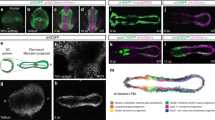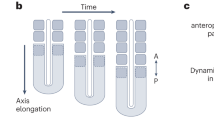Abstract
Endodermal organs such as the lung, liver and pancreas emerge at precise locations along the primitive gut tube. Although several signalling pathways have been implicated in liver formation1,2, so far no single gene has been identified that exclusively regulates liver specification. In zebrafish, the onset of liver specification is marked by the localized endodermal expression of hhex and prox1 at 22 hours post fertilization. Here we used a screen for mutations affecting endodermal organ morphogenesis to identify a unique phenotype: prometheus (prt) mutants exhibit profound, though transient, defects in liver specification. Positional cloning reveals that prt encodes a previously unidentified Wnt2b homologue. prt/wnt2bb is expressed in restricted bilateral domains in the lateral plate mesoderm directly adjacent to the liver-forming endoderm. Mosaic analyses show the requirement for Prt/Wnt2bb in the lateral plate mesoderm, in agreement with the inductive properties of Wnt signalling. Taken together, these data reveal an unexpected positive role for Wnt signalling in liver specification, and indicate a possible common theme for the localized formation of endodermal organs along the gut tube.
This is a preview of subscription content, access via your institution
Access options
Subscribe to this journal
Receive 51 print issues and online access
$199.00 per year
only $3.90 per issue
Buy this article
- Purchase on Springer Link
- Instant access to full article PDF
Prices may be subject to local taxes which are calculated during checkout




Similar content being viewed by others
References
Lemaigre, F. & Zaret, K. S. Liver development update: new embryo models, cell lineage control, and morphogenesis. Curr. Opin. Genet. Dev. 14, 582–590 (2004)
Zhao, R. & Duncan, S. A. Embryonic development of the liver. Hepatology 41, 956–967 (2005)
Lee, C. S., Friedman, J. R., Fulmer, J. T. & Kaestner, K. H. The initiation of liver development is dependent on Foxa transcription factors. Nature 435, 944–947 (2005)
Holtzinger, A. & Evans, T. Gata4 regulates the formation of multiple organs. Development 132, 4005–4014 (2005)
Field, H. A., Ober, E. A., Roeser, T. & Stainier, D. Y. Formation of the digestive system in zebrafish. I. Liver morphogenesis. Dev. Biol. 253, 279–290 (2003)
Le Douarin, N. M. An experimental analysis of liver development. Med. Biol. 53, 427–455 (1975)
Fukuda-Taira, S. Hepatic induction in the avian embryo: specificity of reactive endoderm and inductive mesoderm. J. Embryol. Exp. Morphol. 63, 111–125 (1981)
Jung, J., Zheng, M., Goldfarb, M. & Zaret, K. S. Initiation of mammalian liver development from endoderm by fibroblast growth factors. Science 284, 1998–2003 (1999)
Rossi, J. M., Dunn, N. R., Hogan, B. L. & Zaret, K. S. Distinct mesodermal signals, including BMPs from the septum transversum mesenchyme, are required in combination for hepatogenesis from the endoderm. Genes Dev. 15, 1998–2009 (2001)
Ng, J. K. et al. The limb identity gene Tbx5 promotes limb initiation by interacting with Wnt2b and Fgf10. Development 129, 5161–5170 (2002)
Landesman, Y. & Sokol, S. Y. Xwnt-2b is a novel axis-inducing Xenopus Wnt, which is expressed in embryonic brain. Mech. Dev. 63, 199–209 (1997)
Lewis, J. L. et al. Reiterated Wnt signaling during zebrafish neural crest development. Development 131, 1299–1308 (2004)
Jasoni, C., Hendrickson, A. & Roelink, H. Analysis of chicken Wnt-13 expression demonstrates coincidence with cell division in the developing eye and is consistent with a role in induction. Dev. Dyn. 215, 215–224 (1999)
Zakin, L. D. et al. Structure and expression of Wnt13, a novel mouse Wnt2 related gene. Mech. Dev. 73, 107–116 (1998)
Matsumoto, K., Yoshitomi, H., Rossant, J. & Zaret, K. S. Liver organogenesis promoted by endothelial cells prior to vascular function. Science 294, 559–563 (2001)
Zorn, A. M., Butler, K. & Gurdon, J. B. Anterior endomesoderm specification in Xenopus by Wnt/β-catenin and TGF-β signalling pathways. Dev. Biol. 209, 282–297 (1999)
Suksaweang, S. et al. Morphogenesis of chicken liver: identification of localized growth zones and the role of β-catenin/Wnt in size regulation. Dev. Biol. 266, 109–122 (2004)
Hussain, S. Z. et al. Wnt impacts growth and differentiation in ex vivo liver development. Exp. Cell Res. 292, 157–169 (2004)
Monga, S. P., Pediaditakis, P., Mule, K., Stolz, D. B. & Michalopoulos, G. K. Changes in WNT/β-catenin pathway during regulated growth in rat liver regeneration. Hepatology 33, 1098–1109 (2001)
Bort, R., Martinez-Barbera, J. P., Beddington, R. S. & Zaret, K. S. Hex homeobox gene-dependent tissue positioning is required for organogenesis of the ventral pancreas. Development 131, 797–806 (2004)
Sosa-Pineda, B., Wigle, J. T. & Oliver, G. Hepatocyte migration during liver development requires Prox1. Nature Genet. 25, 254–255 (2000)
Finley, K. R., Tennessen, J. & Shawlot, W. The mouse secreted frizzled-related protein 5 gene is expressed in the anterior visceral endoderm and foregut endoderm during early post-implantation development. Gene Expr. Patterns 3, 681–684 (2003)
Pilcher, K. E. & Krieg, P. A. Expression of the Wnt inhibitor, sFRP5, in the gut endoderm of Xenopus. Gene Expr. Patterns 2, 369–372 (2002)
Horne-Badovinac, S., Rebagliati, M. & Stainier, D. Y. A cellular framework for gut-looping morphogenesis in zebrafish. Science 302, 662–665 (2003)
Roberts, D. J., Smith, D. M., Goff, D. J. & Tabin, C. J. Epithelial-mesenchymal signaling during the regionalization of the chick gut. Development 125, 2791–2801 (1998)
Wells, J. M. & Melton, D. A. Early mouse endoderm is patterned by soluble factors from adjacent germ layers. Development 127, 1563–1572 (2000)
Kumar, M., Jordan, N., Melton, D. & Grapin-Botton, A. Signals from lateral plate mesoderm instruct endoderm toward a pancreatic fate. Dev. Biol. 259, 109–122 (2003)
Kusserow, A. et al. Unexpected complexity of the Wnt gene family in a sea anemone. Nature 433, 156–160 (2005)
McBride, H. J., Fatke, B. & Fraser, S. E. Wnt signaling components in the chicken intestinal tract. Dev. Biol. 256, 18–33 (2003)
Theodosiou, N. A. & Tabin, C. J. Wnt signaling during development of the gastrointestinal tract. Dev. Biol. 259, 258–271 (2003)
Acknowledgements
We thank all the members of the Stainier laboratory for their support during the screen; A. Ayala, S. Waldron and N. Zvenigorodsky for expert help with the fish; L. Trinh, S.-W. Jin, H. Knaut and J.-P. Vincent for discussions and critical readings of the manuscript; S. Pleasure for providing a Prox1 antibody before commercialization; and R. Dorsky for providing Tg(hsΔTcf3-GFP). E.A.O. was supported by the UCSF Liver Center through an NIH pilot feasibility grant, and H.V. by a long-term fellowship of the Human Frontier Science Program. This work was supported in part by grants from the NIH (NIDDK) and the Packard Foundation to D.Y.R.S.
Author information
Authors and Affiliations
Corresponding authors
Ethics declarations
Competing interests
The prt/wnt2bb sequence is deposited in GenBank under accession number DQ231559. Reprints and permissions information is available at npg.nature.com/reprintsandpermissions. The authors declare no competing financial interests.
Supplementary information
Supplementary Notes
This file contains the Supplementary Methods and Supplementary Figure Legends. (DOC 55 kb)
Supplementary Figure 1
Schematic of the phylogenetic relationship between zebrafish , mouse, rat and human Wnt2 and Wnt2b genes. (JPG 22 kb)
Supplementary Figure 2
Linking liver formation and Wnt2bb to canonical Wnt signaling. (JPG 101 kb)
Rights and permissions
About this article
Cite this article
Ober, E., Verkade, H., Field, H. et al. Mesodermal Wnt2b signalling positively regulates liver specification. Nature 442, 688–691 (2006). https://doi.org/10.1038/nature04888
Received:
Accepted:
Published:
Issue Date:
DOI: https://doi.org/10.1038/nature04888
This article is cited by
-
Wdr5-mediated H3K4me3 coordinately regulates cell differentiation, proliferation termination, and survival in digestive organogenesis
Cell Death Discovery (2023)
-
Tmem88 confines ectodermal Wnt2bb signaling in pharyngeal arch artery progenitors for balancing cell cycle progression and cell fate decision
Nature Cardiovascular Research (2023)
-
All routes lead to Rome: multifaceted origin of hepatocytes during liver regeneration
Cell Regeneration (2021)
-
Wnt8a is one of the candidate genes that play essential roles in the elongation of the seahorse prehensile tail
Marine Life Science & Technology (2021)
-
Wnt signaling in breast cancer: biological mechanisms, challenges and opportunities
Molecular Cancer (2020)
Comments
By submitting a comment you agree to abide by our Terms and Community Guidelines. If you find something abusive or that does not comply with our terms or guidelines please flag it as inappropriate.



